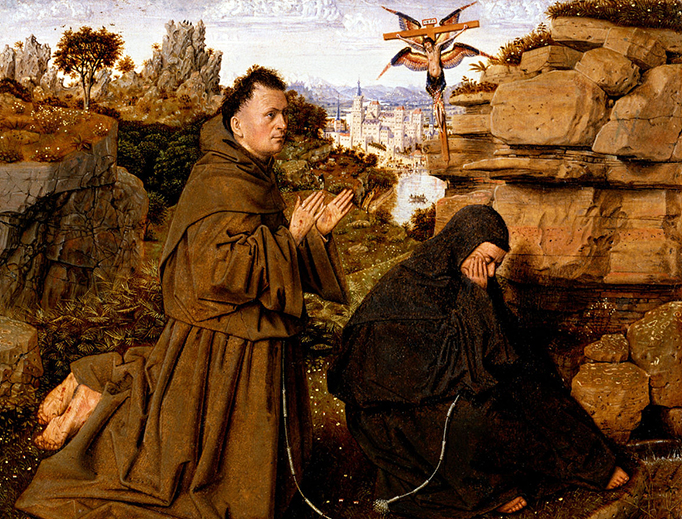On This Day, 794 Years Ago, St. Francis Received the Stigmata
In his biography of St. Francis, St. Bonaventure mentions the pope giving a sermon in which he attests to having seen the wounds with his own eyes.

In a previous article, I mentioned that my third favorite Christian holiday after Easter and Christmas was the Feast of the Transverberation of St. Teresa of Ávila (Aug. 26). I’m greatly devoted to her, as is anyone who has read her books.
Today, I’d like to tell you of yet another of my favorite Catholic holidays. On Sept. 17, Franciscans around the world, secular and otherwise, celebrate the Feast of the Stigmata. Upon this day, between two boulders in La Verna in Umbria, just outside of Assisi, St. Francis received the mark of Christ’s wounds upon his very flesh.
After praying that he wanted to experience, as was possible in his own body, the Passion of Our Lord, Jesus Christ, Francis had a vision of a seraph, or perhaps God Himself―the translation isn’t very clear―which bestowed upon him Christ’s Five Wounds.
He was the first human being in history to have been graced thusly.
There is a very important similarity between the two feast days―one Carmelite and the other Franciscan―both mark the rare but beautiful mystical linking of the human with the divine―between nature and its God. Between the creature and the Creator. The promise of meeting one’s maker after we die is already known to humanity. However, in the case of Francis’ stigmata and the mystical piercing of Teresa’s heart, these two holy people were still alive when they met their Lover. Their mystical experience long sought after was rewarded with debilitatingly sweet pain that made both swoon. We can expect nothing less after seeing the Face of God.
St. Bonaventure, also known as the Seraphic Doctor, wrote a description of the event:
Two years before the faithful servant and minister of Christ, St. Francis, gave up his spirit to God, he retired alone into a high place, which is called Mount Alverna, and began a fast of 40 days in honor of the Archangel St. Michael. The sweetness of heavenly contemplation was poured out on him more abundantly than usual, till, burning with the flame of celestial desires, he began to feel an increasing overflow of divine favors. While the seraphic ardor of his desires thus raised him up to God, and the tenderness of his love and compassion was transforming him into Christ the crucified Victim of excessive love, one morning about the Feast of the Exaltation of the Holy Cross, as he was praying on the mountain-side, he saw what appeared to be a Seraph, with six shining and fiery wings, coming down from Heaven. The vision flew swiftly through the air and approached the man of God, who then perceived that it was not only winged, but also crucified; for the hands and feet were stretched out and fastened to a cross; while the wings were arranged in a wondrous manner—two being raised above the head, two outstretched in flight, and the remaining two crossed over and veiling the whole body. As he gazed, St. Francis was much astonished, and his soul was filled with mingled joy and sorrow. The gracious aspect of Him, Who appeared in so wonderful and loving a manner, rejoiced him exceedingly, while the sight of His cruel crucifixion pierced his heart with a sword of sorrowing compassion.
He Who appeared outwardly to St. Francis, taught him inwardly that, although weakness and suffering are incompatible with the immortal life of a seraph, yet this vision had been shown to him to the end that he, a friend of Christ, might learn how his whole being was to be transformed into a living image of Christ crucified, not by martyrdom of the flesh, but by the burning ardor of his soul. After a mysterious and familiar colloquy, the vision disappeared, leaving the Saint's mind burning with seraphic ardor, and his flesh impressed with an exact image of the Crucified, as though, after the melting power of that fire, it had next been stamped with a seal. For immediately the marks of nails began to appear in his hands and feet, their heads showing in the palms of his hands and the upper part of his feet, and their points visible on the other side. There was also a red scar on his right side, as if it had been wounded by a lance, and from which blood often flowed staining his tunic and underclothing.
Compare St. Bonaventure’s account with St. Teresa’s autobiographical account of her Transverberation:
I saw an angel beside me toward the left side, in bodily form. He was not very large, but small, very beautiful, his face so blazing with light that he seemed to be one of the very highest angels, who appear all on fire. They must be those they call Cherubim…I saw in his hands a long dart of gold, and at the end of the iron there seemed to me to be a little fire. This I thought he thrust through my heart several times, and that it reached my very entrails. As he withdrew it, I thought it brought them with it, and left me all burning with a great love of God. So great was the pain that it made me give those moans; and so utter the sweetness that this sharpest of pains gave me, that there was no wanting it to stop, nor is there any contenting of the soul with less than God.” (St. Teresa, Life…Chapter 19)
Mercifully, there have been countless Christians who have been blessed with religious experiences in the past two millennia. However, Francis’ experience is unique in that he was the first person to ever experience the stigmata. Further, he is one of the few male mystics to have received the marks. That list includes Padre Pio and St. John of God. Apparently, 80 percent or so of stigmatics are women.

When St. Francis was honored by this new and amazing miracle, he became like a new man. This blessing was engraved upon his very flesh by God’s Hand.
Even though he was grateful for this incredible honor, Francis took great pains to hide these sacred marks from curious eyes. However, when necessary, he exposed them and on exposing them, he worked miracles in God’s name.
Nearly a month after he canonized St. Clair in 1255, Pope Alexander IV confirmed the legitimacy of Francis’ stigmata. Further, in his biography of St. Francis, St. Bonaventure mentions the pope giving a sermon in which he attests to having seen the wounds with his own eyes.
In 1304, Pope Benedict XI created the Solemnity of the Feast of Francis’ Stigmata. Pope Paul V, Galileo’s best friend until the astronomer got uppity and insulting, extended this feast to the entire Church in the general calendar.













